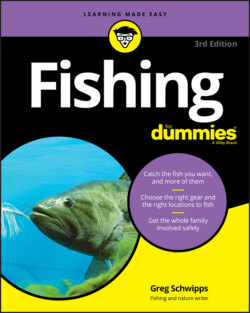Читать книгу Fishing For Dummies - Greg Schwipps - Страница 39
Pull on waders to wander into the fish’s world
ОглавлениеIf you plan on doing any stream wading or surfcasting, you need waders. Although you can wade in the warmest months wearing little more than shorts and sneakers, to fish in cooler water, waders offer you warmth and dryness. Essentially, waders are waterproof hip boots or overalls meant to cover at least part of your legs and possibly your torso. The first time you wade into a stream wearing waders, you’ll marvel at the experience. Standing in the stream almost chest-deep, with the current gently swirling around you, is a little like becoming a fish yourself.
Waders come in a variety of styles, made from a few different kinds of materials. Waders, like tents and boots, are meant to be waterproof. But like tents and boots, waders suffer tears and punctures. Luckily, many times a hole can be patched.
Waders come in several different styles, and are available almost anywhere tackle is sold:
Boot-foot waders: This one-piece chest-high outfit has rubber boots attached to the legs of the waders, making it the most convenient design for dressing in a hurry. It is also the only design for surfcasting because sand or pebbles cannot find their way into your boots.Often, when you buy boot-foot waders, you have to choose between getting felt or lugs on the soles of the boots. When rocks are covered with algae, wet leaves, dead seaweed, or unidentifiable slime, they are very slippery. Felt soles cling and help to counteract the slipperiness. Lugged soles are okay, too, but you won’t get the traction on slippery rocks that you’ll find with felt soles. If you fish mostly in sand or mud, lugged soles will work fine. Note: On some streams, felt is illegal because of its tendency to transfer invasive species. To counter that, some manufacturers now offer soles made of things like crushed walnut shells. Look for these eco-friendly soles, or use cleats or lugs.
Stocking-foot waders: Stocking-foot waders (which are also chest high) do not come with boots attached, so they require wading shoes. Many anglers prefer this style because they say sturdy wading shoes give them extra support while wading.
Hip waders: Great for fishing streams in the summer. Hip boots reach your upper thigh, and can often be attached to your belt with garter-type straps (insert your own joke here). You can’t go nearly as deep in hip waders as you can with chest-high waders, but if the river never gets that deep, why roast inside of chest waders? You’ll also find it easier to go to the restroom while wearing hip boots.
Some wading shoes, like those made by Korker, feature interchangeable soles. You can also buy strap-on cleats that fit over your existing soles. These let you switch quickly from felt to cleats to match the conditions. Metal cleats are helpful when climbing on slippery jetty rocks.
Waders are often made of the following three materials, and vary in durability and comfort:
Neoprene: The material used in wet suits, neoprene works well if you are fishing in cold waters. Walking around in neoprene waders on a hot day, you’ll feel like a baked potato in a microwave oven. Neoprene punctures, like rubber ones, can be resealed. Neoprene waders keep you warm in water below 60 degrees F.
Rubber and nylon: The least expensive of the bunch, rubber waders are basically rubber boots that “go all the way up.” Most feature reinforced knee patches and factory-sealed seams. They can last a long time if cared for.
Breathables: Made of Gore-Tex and other fancy materials, breathable waders are the most expensive, but they’re ultra-comfortable. The breathable membranes of these waders allow you to stay cooler in warmer months.
Here's some advice from Peter: When I was a kid, we always had a laugh at the “old guys” who wore belts and suspenders. I still think it’s kind of overkill for streetwear, but with most waders it’s a must. You wear suspenders to hold up your waders, and the belt keeps water from rushing in if you get a dunking. This is a serious safety precaution. You can drown if your waders fill up.
